Business Environment Report: Tesco and Economic Factors Analysis
VerifiedAdded on 2020/07/22
|12
|3077
|111
Report
AI Summary
This report delves into the multifaceted aspects of the business environment, providing a comprehensive analysis of factors influencing business operations. The report begins with an introduction to the concept of business environments, distinguishing between internal and external factors and their impacts on organizations, using Tesco as a case study. Task 1 explores the types, purpose, and ownership of businesses, contrasting two businesses, and identifying and describing internal and external stakeholders. Task 2 examines organizational structures and how these structures fulfill business purposes, with a focus on Tesco's mission and values. Task 3 investigates the influence of economic environments on business activities, comparing challenges in different economic contexts. Task 4 analyzes the impact of political, legal, and social factors on business activities, evaluating future changes and their effects. The report includes a conclusion summarizing the key findings and a list of references.
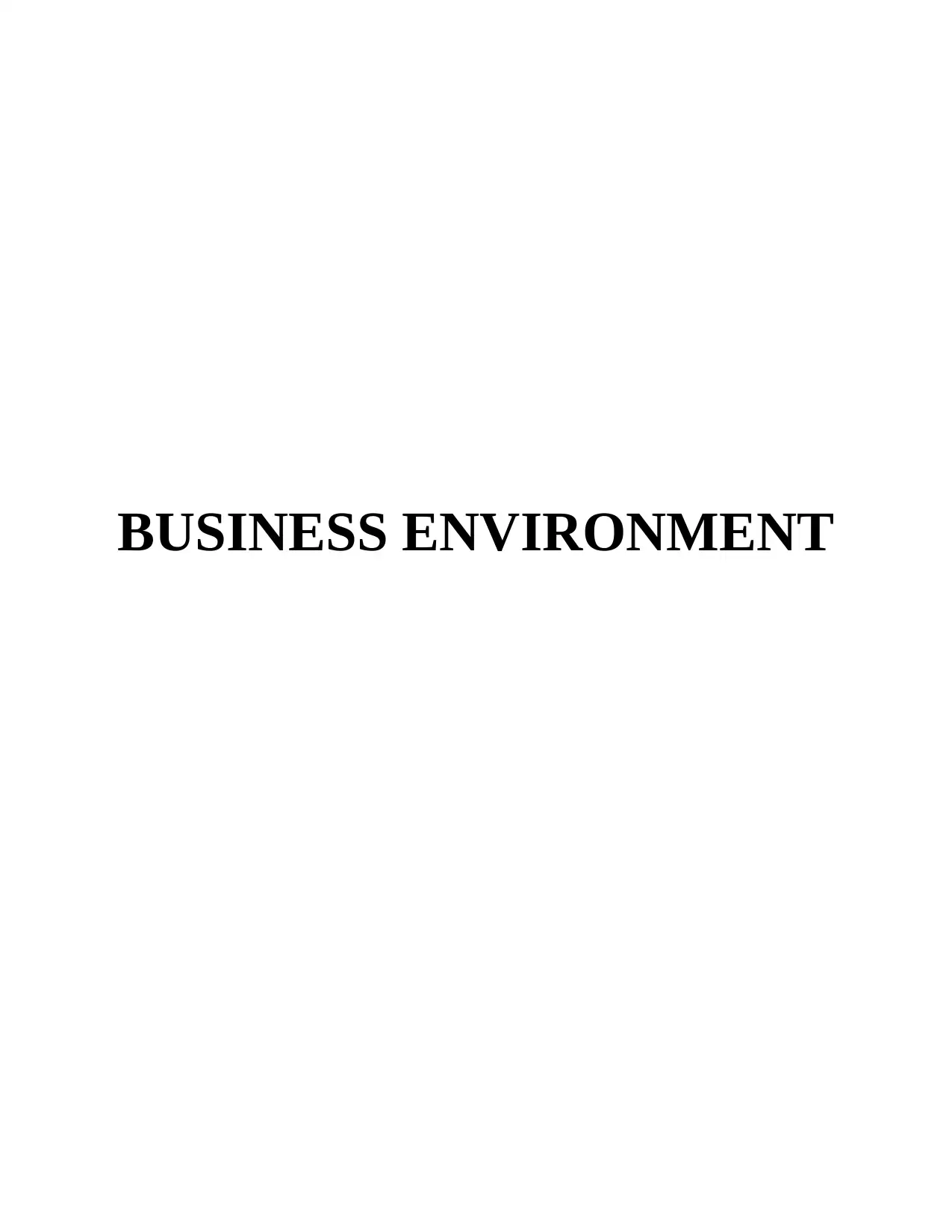
BUSINESS ENVIRONMENT
Paraphrase This Document
Need a fresh take? Get an instant paraphrase of this document with our AI Paraphraser
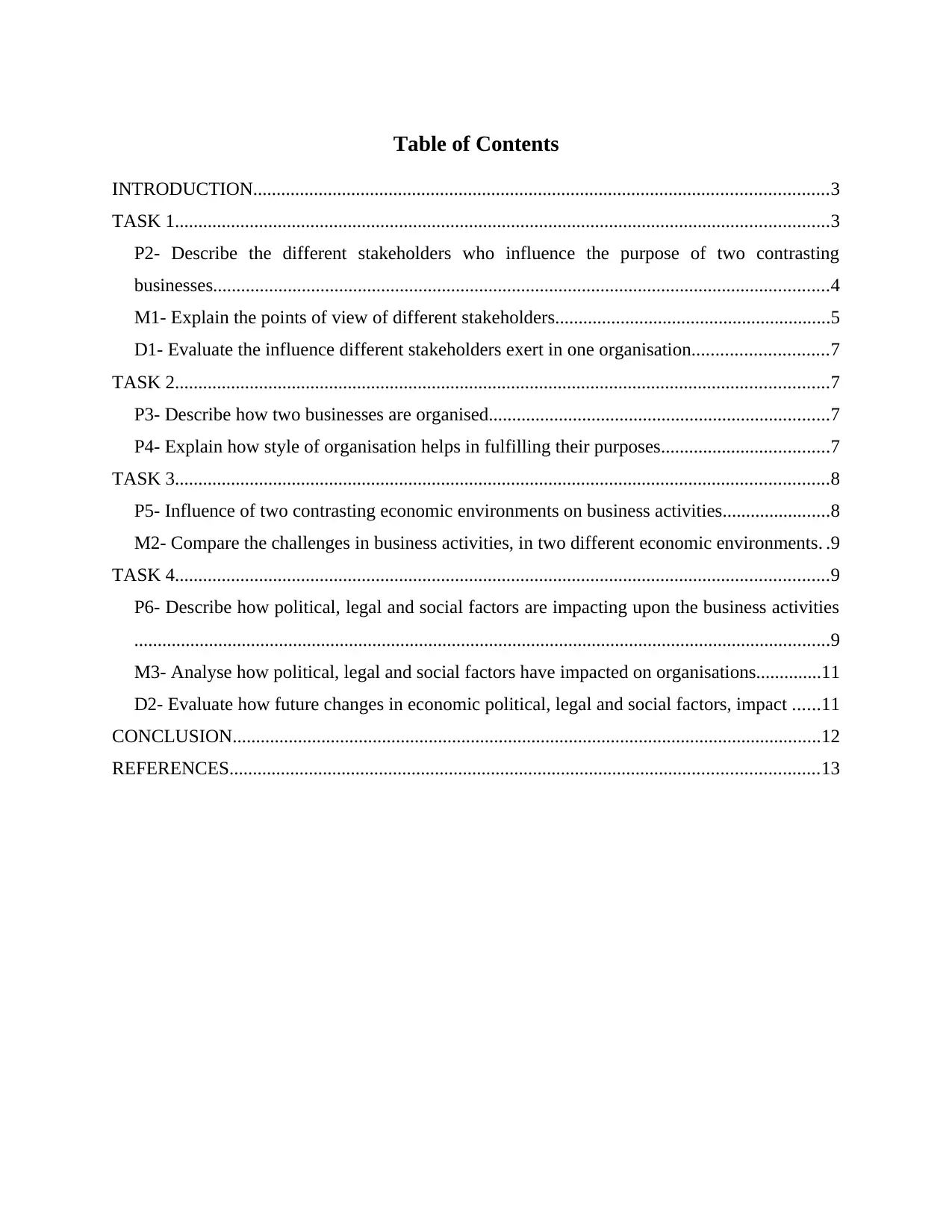
Table of Contents
INTRODUCTION...........................................................................................................................3
TASK 1............................................................................................................................................3
P2- Describe the different stakeholders who influence the purpose of two contrasting
businesses....................................................................................................................................4
M1- Explain the points of view of different stakeholders...........................................................5
D1- Evaluate the influence different stakeholders exert in one organisation.............................7
TASK 2............................................................................................................................................7
P3- Describe how two businesses are organised.........................................................................7
P4- Explain how style of organisation helps in fulfilling their purposes....................................7
TASK 3............................................................................................................................................8
P5- Influence of two contrasting economic environments on business activities.......................8
M2- Compare the challenges in business activities, in two different economic environments. .9
TASK 4............................................................................................................................................9
P6- Describe how political, legal and social factors are impacting upon the business activities
.....................................................................................................................................................9
M3- Analyse how political, legal and social factors have impacted on organisations..............11
D2- Evaluate how future changes in economic political, legal and social factors, impact ......11
CONCLUSION..............................................................................................................................12
REFERENCES..............................................................................................................................13
INTRODUCTION...........................................................................................................................3
TASK 1............................................................................................................................................3
P2- Describe the different stakeholders who influence the purpose of two contrasting
businesses....................................................................................................................................4
M1- Explain the points of view of different stakeholders...........................................................5
D1- Evaluate the influence different stakeholders exert in one organisation.............................7
TASK 2............................................................................................................................................7
P3- Describe how two businesses are organised.........................................................................7
P4- Explain how style of organisation helps in fulfilling their purposes....................................7
TASK 3............................................................................................................................................8
P5- Influence of two contrasting economic environments on business activities.......................8
M2- Compare the challenges in business activities, in two different economic environments. .9
TASK 4............................................................................................................................................9
P6- Describe how political, legal and social factors are impacting upon the business activities
.....................................................................................................................................................9
M3- Analyse how political, legal and social factors have impacted on organisations..............11
D2- Evaluate how future changes in economic political, legal and social factors, impact ......11
CONCLUSION..............................................................................................................................12
REFERENCES..............................................................................................................................13
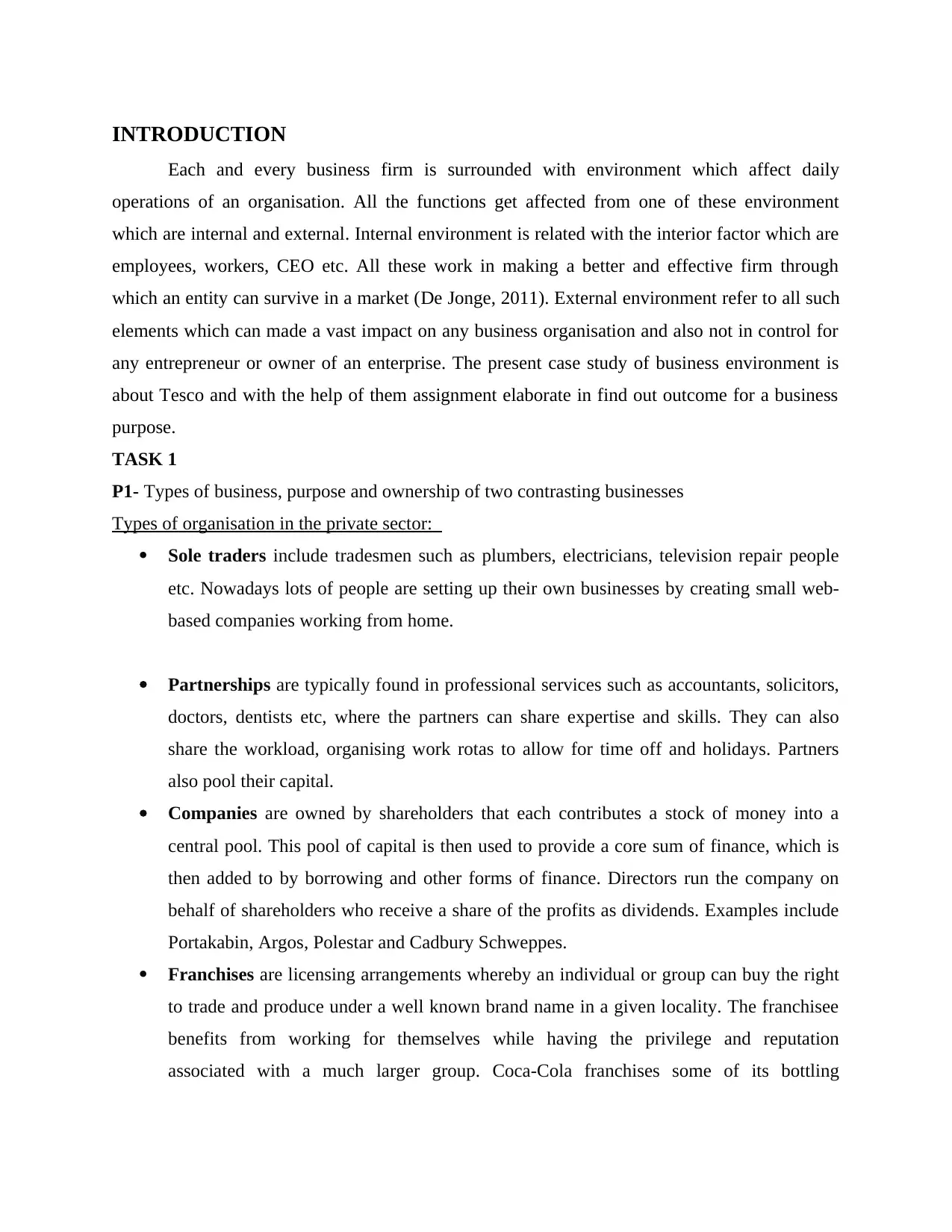
INTRODUCTION
Each and every business firm is surrounded with environment which affect daily
operations of an organisation. All the functions get affected from one of these environment
which are internal and external. Internal environment is related with the interior factor which are
employees, workers, CEO etc. All these work in making a better and effective firm through
which an entity can survive in a market (De Jonge, 2011). External environment refer to all such
elements which can made a vast impact on any business organisation and also not in control for
any entrepreneur or owner of an enterprise. The present case study of business environment is
about Tesco and with the help of them assignment elaborate in find out outcome for a business
purpose.
TASK 1
P1- Types of business, purpose and ownership of two contrasting businesses
Types of organisation in the private sector:
Sole traders include tradesmen such as plumbers, electricians, television repair people
etc. Nowadays lots of people are setting up their own businesses by creating small web-
based companies working from home.
Partnerships are typically found in professional services such as accountants, solicitors,
doctors, dentists etc, where the partners can share expertise and skills. They can also
share the workload, organising work rotas to allow for time off and holidays. Partners
also pool their capital.
Companies are owned by shareholders that each contributes a stock of money into a
central pool. This pool of capital is then used to provide a core sum of finance, which is
then added to by borrowing and other forms of finance. Directors run the company on
behalf of shareholders who receive a share of the profits as dividends. Examples include
Portakabin, Argos, Polestar and Cadbury Schweppes.
Franchises are licensing arrangements whereby an individual or group can buy the right
to trade and produce under a well known brand name in a given locality. The franchisee
benefits from working for themselves while having the privilege and reputation
associated with a much larger group. Coca-Cola franchises some of its bottling
Each and every business firm is surrounded with environment which affect daily
operations of an organisation. All the functions get affected from one of these environment
which are internal and external. Internal environment is related with the interior factor which are
employees, workers, CEO etc. All these work in making a better and effective firm through
which an entity can survive in a market (De Jonge, 2011). External environment refer to all such
elements which can made a vast impact on any business organisation and also not in control for
any entrepreneur or owner of an enterprise. The present case study of business environment is
about Tesco and with the help of them assignment elaborate in find out outcome for a business
purpose.
TASK 1
P1- Types of business, purpose and ownership of two contrasting businesses
Types of organisation in the private sector:
Sole traders include tradesmen such as plumbers, electricians, television repair people
etc. Nowadays lots of people are setting up their own businesses by creating small web-
based companies working from home.
Partnerships are typically found in professional services such as accountants, solicitors,
doctors, dentists etc, where the partners can share expertise and skills. They can also
share the workload, organising work rotas to allow for time off and holidays. Partners
also pool their capital.
Companies are owned by shareholders that each contributes a stock of money into a
central pool. This pool of capital is then used to provide a core sum of finance, which is
then added to by borrowing and other forms of finance. Directors run the company on
behalf of shareholders who receive a share of the profits as dividends. Examples include
Portakabin, Argos, Polestar and Cadbury Schweppes.
Franchises are licensing arrangements whereby an individual or group can buy the right
to trade and produce under a well known brand name in a given locality. The franchisee
benefits from working for themselves while having the privilege and reputation
associated with a much larger group. Coca-Cola franchises some of its bottling
⊘ This is a preview!⊘
Do you want full access?
Subscribe today to unlock all pages.

Trusted by 1+ million students worldwide
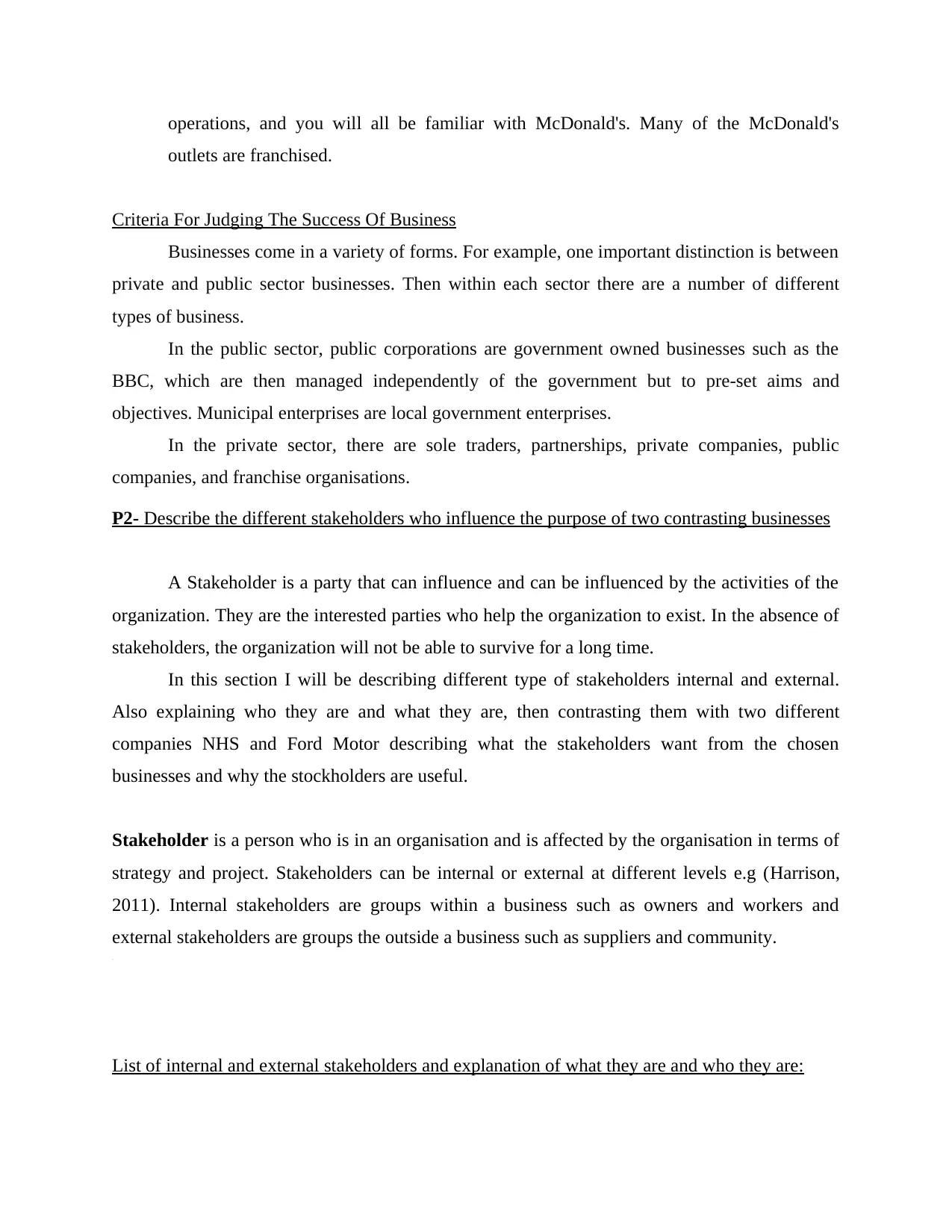
operations, and you will all be familiar with McDonald's. Many of the McDonald's
outlets are franchised.
Criteria For Judging The Success Of Business
Businesses come in a variety of forms. For example, one important distinction is between
private and public sector businesses. Then within each sector there are a number of different
types of business.
In the public sector, public corporations are government owned businesses such as the
BBC, which are then managed independently of the government but to pre-set aims and
objectives. Municipal enterprises are local government enterprises.
In the private sector, there are sole traders, partnerships, private companies, public
companies, and franchise organisations.
P2- Describe the different stakeholders who influence the purpose of two contrasting businesses
A Stakeholder is a party that can influence and can be influenced by the activities of the
organization. They are the interested parties who help the organization to exist. In the absence of
stakeholders, the organization will not be able to survive for a long time.
In this section I will be describing different type of stakeholders internal and external.
Also explaining who they are and what they are, then contrasting them with two different
companies NHS and Ford Motor describing what the stakeholders want from the chosen
businesses and why the stockholders are useful.
Stakeholder is a person who is in an organisation and is affected by the organisation in terms of
strategy and project. Stakeholders can be internal or external at different levels e.g (Harrison,
2011). Internal stakeholders are groups within a business such as owners and workers and
external stakeholders are groups the outside a business such as suppliers and community.
List of internal and external stakeholders and explanation of what they are and who they are:
outlets are franchised.
Criteria For Judging The Success Of Business
Businesses come in a variety of forms. For example, one important distinction is between
private and public sector businesses. Then within each sector there are a number of different
types of business.
In the public sector, public corporations are government owned businesses such as the
BBC, which are then managed independently of the government but to pre-set aims and
objectives. Municipal enterprises are local government enterprises.
In the private sector, there are sole traders, partnerships, private companies, public
companies, and franchise organisations.
P2- Describe the different stakeholders who influence the purpose of two contrasting businesses
A Stakeholder is a party that can influence and can be influenced by the activities of the
organization. They are the interested parties who help the organization to exist. In the absence of
stakeholders, the organization will not be able to survive for a long time.
In this section I will be describing different type of stakeholders internal and external.
Also explaining who they are and what they are, then contrasting them with two different
companies NHS and Ford Motor describing what the stakeholders want from the chosen
businesses and why the stockholders are useful.
Stakeholder is a person who is in an organisation and is affected by the organisation in terms of
strategy and project. Stakeholders can be internal or external at different levels e.g (Harrison,
2011). Internal stakeholders are groups within a business such as owners and workers and
external stakeholders are groups the outside a business such as suppliers and community.
List of internal and external stakeholders and explanation of what they are and who they are:
Paraphrase This Document
Need a fresh take? Get an instant paraphrase of this document with our AI Paraphraser
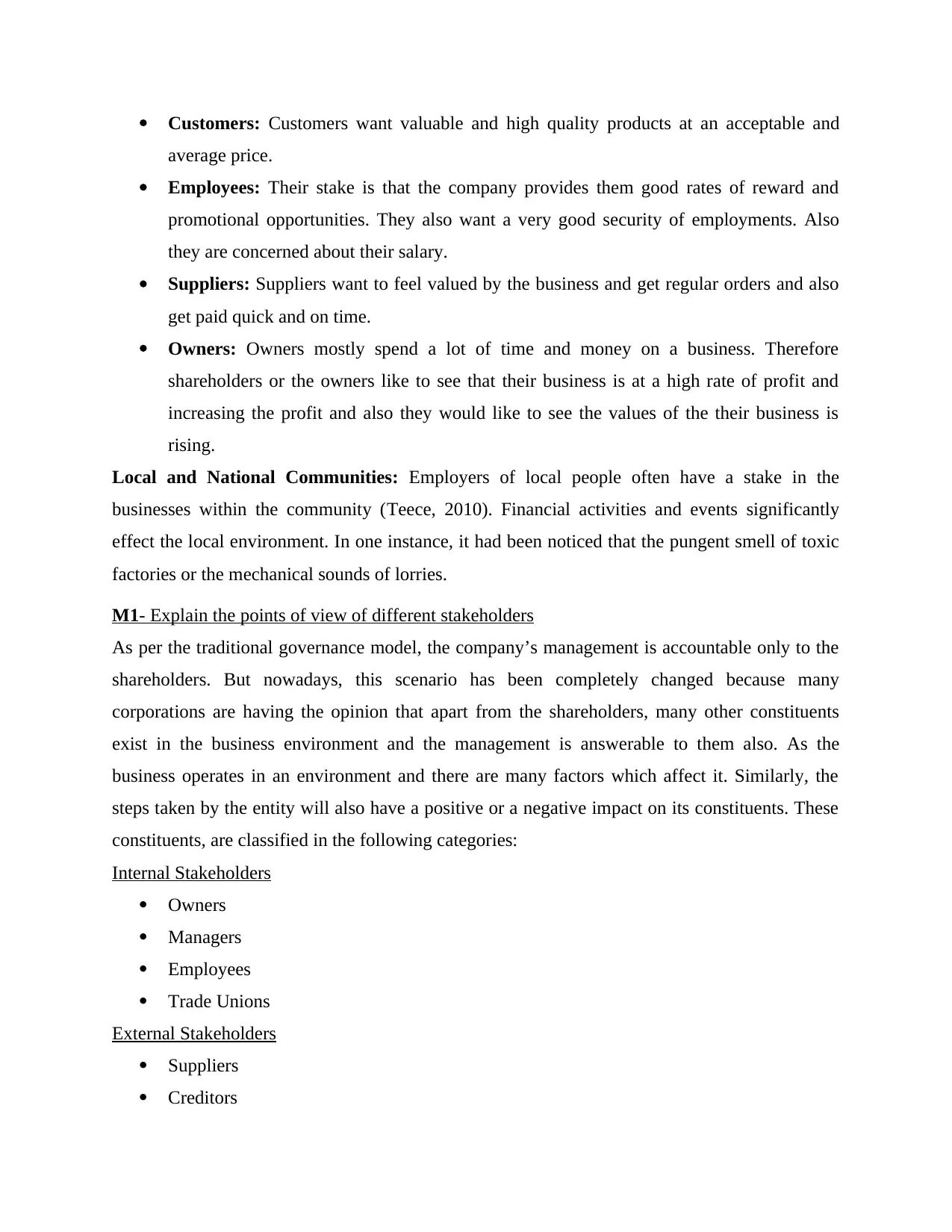
Customers: Customers want valuable and high quality products at an acceptable and
average price.
Employees: Their stake is that the company provides them good rates of reward and
promotional opportunities. They also want a very good security of employments. Also
they are concerned about their salary.
Suppliers: Suppliers want to feel valued by the business and get regular orders and also
get paid quick and on time.
Owners: Owners mostly spend a lot of time and money on a business. Therefore
shareholders or the owners like to see that their business is at a high rate of profit and
increasing the profit and also they would like to see the values of the their business is
rising.
Local and National Communities: Employers of local people often have a stake in the
businesses within the community (Teece, 2010). Financial activities and events significantly
effect the local environment. In one instance, it had been noticed that the pungent smell of toxic
factories or the mechanical sounds of lorries.
M1- Explain the points of view of different stakeholders
As per the traditional governance model, the company’s management is accountable only to the
shareholders. But nowadays, this scenario has been completely changed because many
corporations are having the opinion that apart from the shareholders, many other constituents
exist in the business environment and the management is answerable to them also. As the
business operates in an environment and there are many factors which affect it. Similarly, the
steps taken by the entity will also have a positive or a negative impact on its constituents. These
constituents, are classified in the following categories:
Internal Stakeholders
Owners
Managers
Employees
Trade Unions
External Stakeholders
Suppliers
Creditors
average price.
Employees: Their stake is that the company provides them good rates of reward and
promotional opportunities. They also want a very good security of employments. Also
they are concerned about their salary.
Suppliers: Suppliers want to feel valued by the business and get regular orders and also
get paid quick and on time.
Owners: Owners mostly spend a lot of time and money on a business. Therefore
shareholders or the owners like to see that their business is at a high rate of profit and
increasing the profit and also they would like to see the values of the their business is
rising.
Local and National Communities: Employers of local people often have a stake in the
businesses within the community (Teece, 2010). Financial activities and events significantly
effect the local environment. In one instance, it had been noticed that the pungent smell of toxic
factories or the mechanical sounds of lorries.
M1- Explain the points of view of different stakeholders
As per the traditional governance model, the company’s management is accountable only to the
shareholders. But nowadays, this scenario has been completely changed because many
corporations are having the opinion that apart from the shareholders, many other constituents
exist in the business environment and the management is answerable to them also. As the
business operates in an environment and there are many factors which affect it. Similarly, the
steps taken by the entity will also have a positive or a negative impact on its constituents. These
constituents, are classified in the following categories:
Internal Stakeholders
Owners
Managers
Employees
Trade Unions
External Stakeholders
Suppliers
Creditors
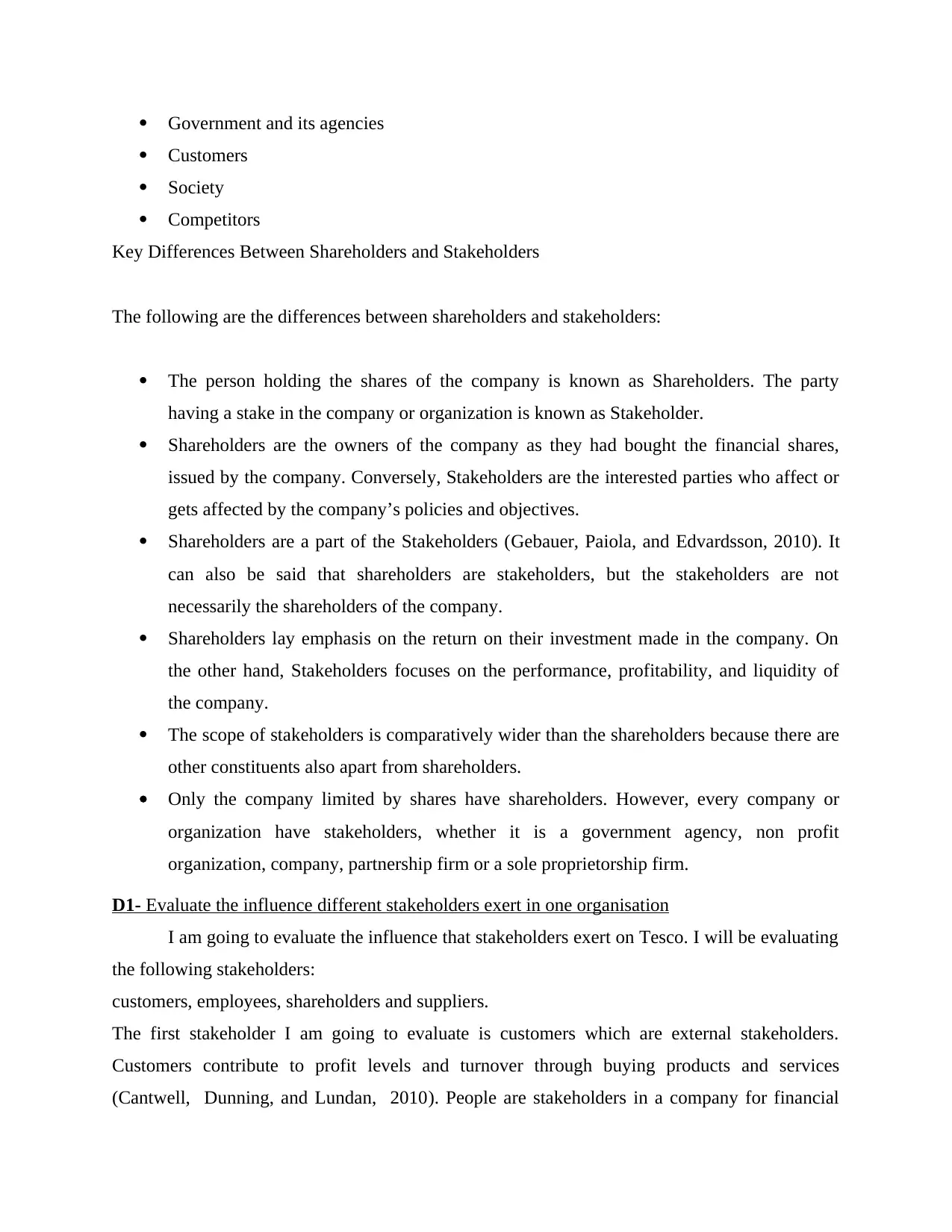
Government and its agencies
Customers
Society
Competitors
Key Differences Between Shareholders and Stakeholders
The following are the differences between shareholders and stakeholders:
The person holding the shares of the company is known as Shareholders. The party
having a stake in the company or organization is known as Stakeholder.
Shareholders are the owners of the company as they had bought the financial shares,
issued by the company. Conversely, Stakeholders are the interested parties who affect or
gets affected by the company’s policies and objectives.
Shareholders are a part of the Stakeholders (Gebauer, Paiola, and Edvardsson, 2010). It
can also be said that shareholders are stakeholders, but the stakeholders are not
necessarily the shareholders of the company.
Shareholders lay emphasis on the return on their investment made in the company. On
the other hand, Stakeholders focuses on the performance, profitability, and liquidity of
the company.
The scope of stakeholders is comparatively wider than the shareholders because there are
other constituents also apart from shareholders.
Only the company limited by shares have shareholders. However, every company or
organization have stakeholders, whether it is a government agency, non profit
organization, company, partnership firm or a sole proprietorship firm.
D1- Evaluate the influence different stakeholders exert in one organisation
I am going to evaluate the influence that stakeholders exert on Tesco. I will be evaluating
the following stakeholders:
customers, employees, shareholders and suppliers.
The first stakeholder I am going to evaluate is customers which are external stakeholders.
Customers contribute to profit levels and turnover through buying products and services
(Cantwell, Dunning, and Lundan, 2010). People are stakeholders in a company for financial
Customers
Society
Competitors
Key Differences Between Shareholders and Stakeholders
The following are the differences between shareholders and stakeholders:
The person holding the shares of the company is known as Shareholders. The party
having a stake in the company or organization is known as Stakeholder.
Shareholders are the owners of the company as they had bought the financial shares,
issued by the company. Conversely, Stakeholders are the interested parties who affect or
gets affected by the company’s policies and objectives.
Shareholders are a part of the Stakeholders (Gebauer, Paiola, and Edvardsson, 2010). It
can also be said that shareholders are stakeholders, but the stakeholders are not
necessarily the shareholders of the company.
Shareholders lay emphasis on the return on their investment made in the company. On
the other hand, Stakeholders focuses on the performance, profitability, and liquidity of
the company.
The scope of stakeholders is comparatively wider than the shareholders because there are
other constituents also apart from shareholders.
Only the company limited by shares have shareholders. However, every company or
organization have stakeholders, whether it is a government agency, non profit
organization, company, partnership firm or a sole proprietorship firm.
D1- Evaluate the influence different stakeholders exert in one organisation
I am going to evaluate the influence that stakeholders exert on Tesco. I will be evaluating
the following stakeholders:
customers, employees, shareholders and suppliers.
The first stakeholder I am going to evaluate is customers which are external stakeholders.
Customers contribute to profit levels and turnover through buying products and services
(Cantwell, Dunning, and Lundan, 2010). People are stakeholders in a company for financial
⊘ This is a preview!⊘
Do you want full access?
Subscribe today to unlock all pages.

Trusted by 1+ million students worldwide
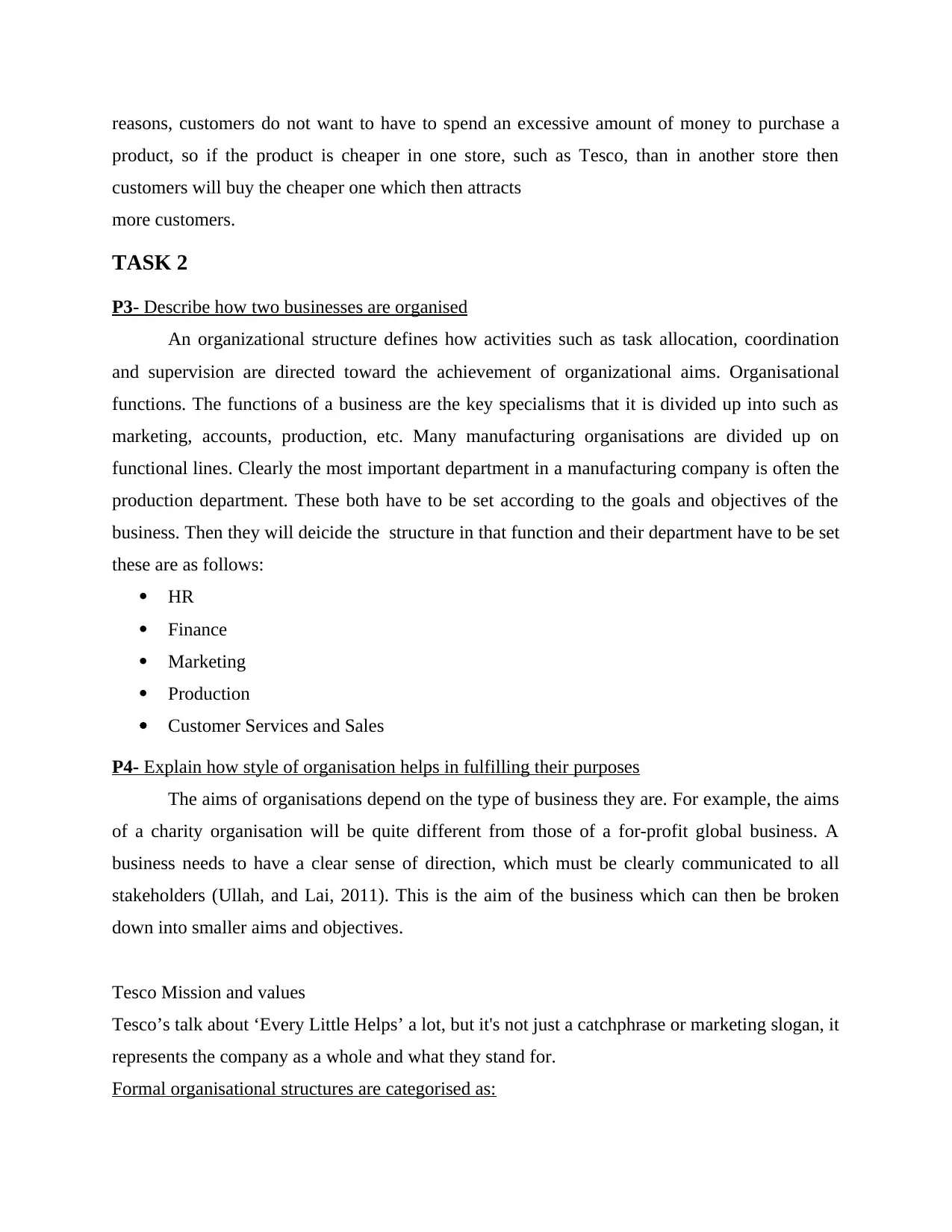
reasons, customers do not want to have to spend an excessive amount of money to purchase a
product, so if the product is cheaper in one store, such as Tesco, than in another store then
customers will buy the cheaper one which then attracts
more customers.
TASK 2
P3- Describe how two businesses are organised
An organizational structure defines how activities such as task allocation, coordination
and supervision are directed toward the achievement of organizational aims. Organisational
functions. The functions of a business are the key specialisms that it is divided up into such as
marketing, accounts, production, etc. Many manufacturing organisations are divided up on
functional lines. Clearly the most important department in a manufacturing company is often the
production department. These both have to be set according to the goals and objectives of the
business. Then they will deicide the structure in that function and their department have to be set
these are as follows:
HR
Finance
Marketing
Production
Customer Services and Sales
P4- Explain how style of organisation helps in fulfilling their purposes
The aims of organisations depend on the type of business they are. For example, the aims
of a charity organisation will be quite different from those of a for-profit global business. A
business needs to have a clear sense of direction, which must be clearly communicated to all
stakeholders (Ullah, and Lai, 2011). This is the aim of the business which can then be broken
down into smaller aims and objectives.
Tesco Mission and values
Tesco’s talk about ‘Every Little Helps’ a lot, but it's not just a catchphrase or marketing slogan, it
represents the company as a whole and what they stand for.
Formal organisational structures are categorised as:
product, so if the product is cheaper in one store, such as Tesco, than in another store then
customers will buy the cheaper one which then attracts
more customers.
TASK 2
P3- Describe how two businesses are organised
An organizational structure defines how activities such as task allocation, coordination
and supervision are directed toward the achievement of organizational aims. Organisational
functions. The functions of a business are the key specialisms that it is divided up into such as
marketing, accounts, production, etc. Many manufacturing organisations are divided up on
functional lines. Clearly the most important department in a manufacturing company is often the
production department. These both have to be set according to the goals and objectives of the
business. Then they will deicide the structure in that function and their department have to be set
these are as follows:
HR
Finance
Marketing
Production
Customer Services and Sales
P4- Explain how style of organisation helps in fulfilling their purposes
The aims of organisations depend on the type of business they are. For example, the aims
of a charity organisation will be quite different from those of a for-profit global business. A
business needs to have a clear sense of direction, which must be clearly communicated to all
stakeholders (Ullah, and Lai, 2011). This is the aim of the business which can then be broken
down into smaller aims and objectives.
Tesco Mission and values
Tesco’s talk about ‘Every Little Helps’ a lot, but it's not just a catchphrase or marketing slogan, it
represents the company as a whole and what they stand for.
Formal organisational structures are categorised as:
Paraphrase This Document
Need a fresh take? Get an instant paraphrase of this document with our AI Paraphraser
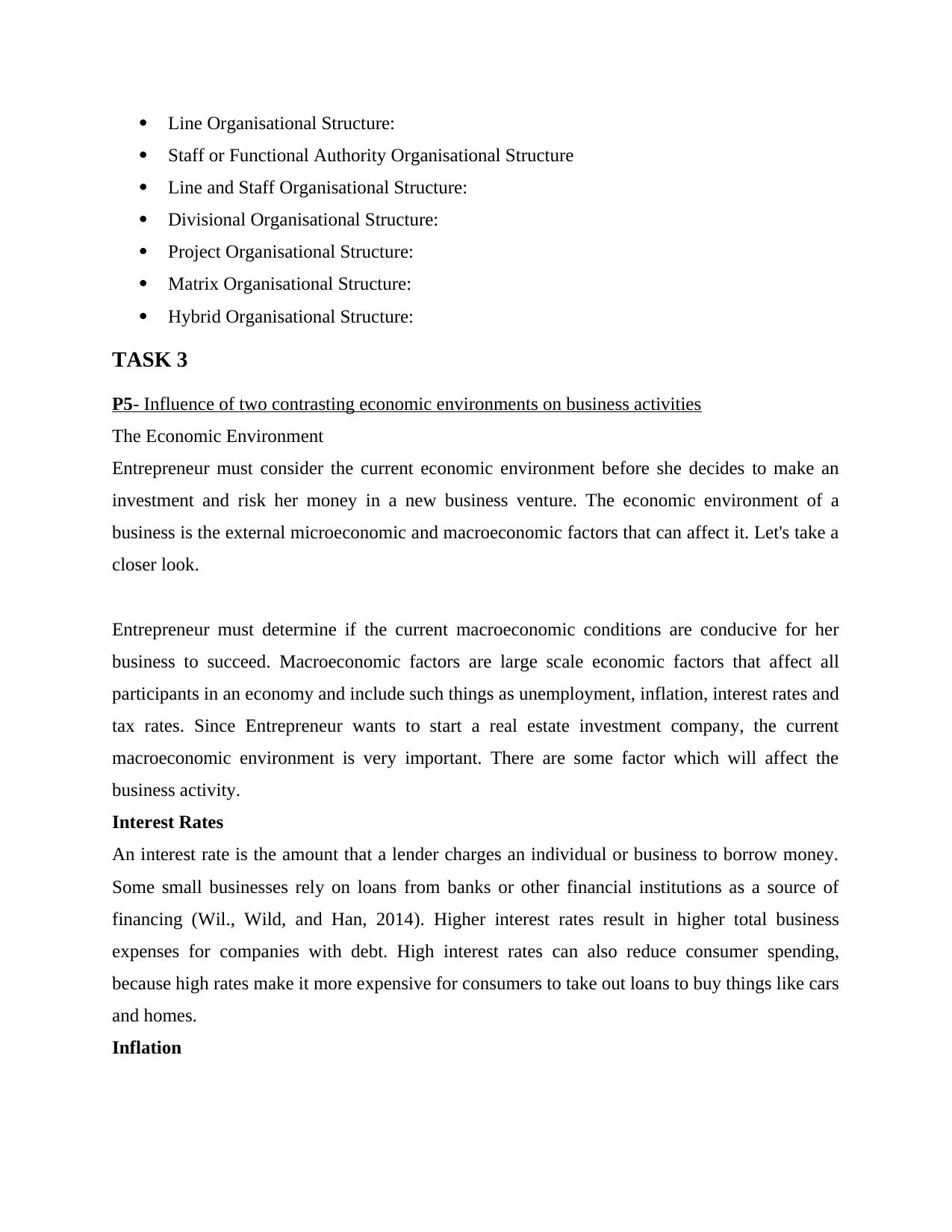
Line Organisational Structure:
Staff or Functional Authority Organisational Structure
Line and Staff Organisational Structure:
Divisional Organisational Structure:
Project Organisational Structure:
Matrix Organisational Structure:
Hybrid Organisational Structure:
TASK 3
P5- Influence of two contrasting economic environments on business activities
The Economic Environment
Entrepreneur must consider the current economic environment before she decides to make an
investment and risk her money in a new business venture. The economic environment of a
business is the external microeconomic and macroeconomic factors that can affect it. Let's take a
closer look.
Entrepreneur must determine if the current macroeconomic conditions are conducive for her
business to succeed. Macroeconomic factors are large scale economic factors that affect all
participants in an economy and include such things as unemployment, inflation, interest rates and
tax rates. Since Entrepreneur wants to start a real estate investment company, the current
macroeconomic environment is very important. There are some factor which will affect the
business activity.
Interest Rates
An interest rate is the amount that a lender charges an individual or business to borrow money.
Some small businesses rely on loans from banks or other financial institutions as a source of
financing (Wil., Wild, and Han, 2014). Higher interest rates result in higher total business
expenses for companies with debt. High interest rates can also reduce consumer spending,
because high rates make it more expensive for consumers to take out loans to buy things like cars
and homes.
Inflation
Staff or Functional Authority Organisational Structure
Line and Staff Organisational Structure:
Divisional Organisational Structure:
Project Organisational Structure:
Matrix Organisational Structure:
Hybrid Organisational Structure:
TASK 3
P5- Influence of two contrasting economic environments on business activities
The Economic Environment
Entrepreneur must consider the current economic environment before she decides to make an
investment and risk her money in a new business venture. The economic environment of a
business is the external microeconomic and macroeconomic factors that can affect it. Let's take a
closer look.
Entrepreneur must determine if the current macroeconomic conditions are conducive for her
business to succeed. Macroeconomic factors are large scale economic factors that affect all
participants in an economy and include such things as unemployment, inflation, interest rates and
tax rates. Since Entrepreneur wants to start a real estate investment company, the current
macroeconomic environment is very important. There are some factor which will affect the
business activity.
Interest Rates
An interest rate is the amount that a lender charges an individual or business to borrow money.
Some small businesses rely on loans from banks or other financial institutions as a source of
financing (Wil., Wild, and Han, 2014). Higher interest rates result in higher total business
expenses for companies with debt. High interest rates can also reduce consumer spending,
because high rates make it more expensive for consumers to take out loans to buy things like cars
and homes.
Inflation
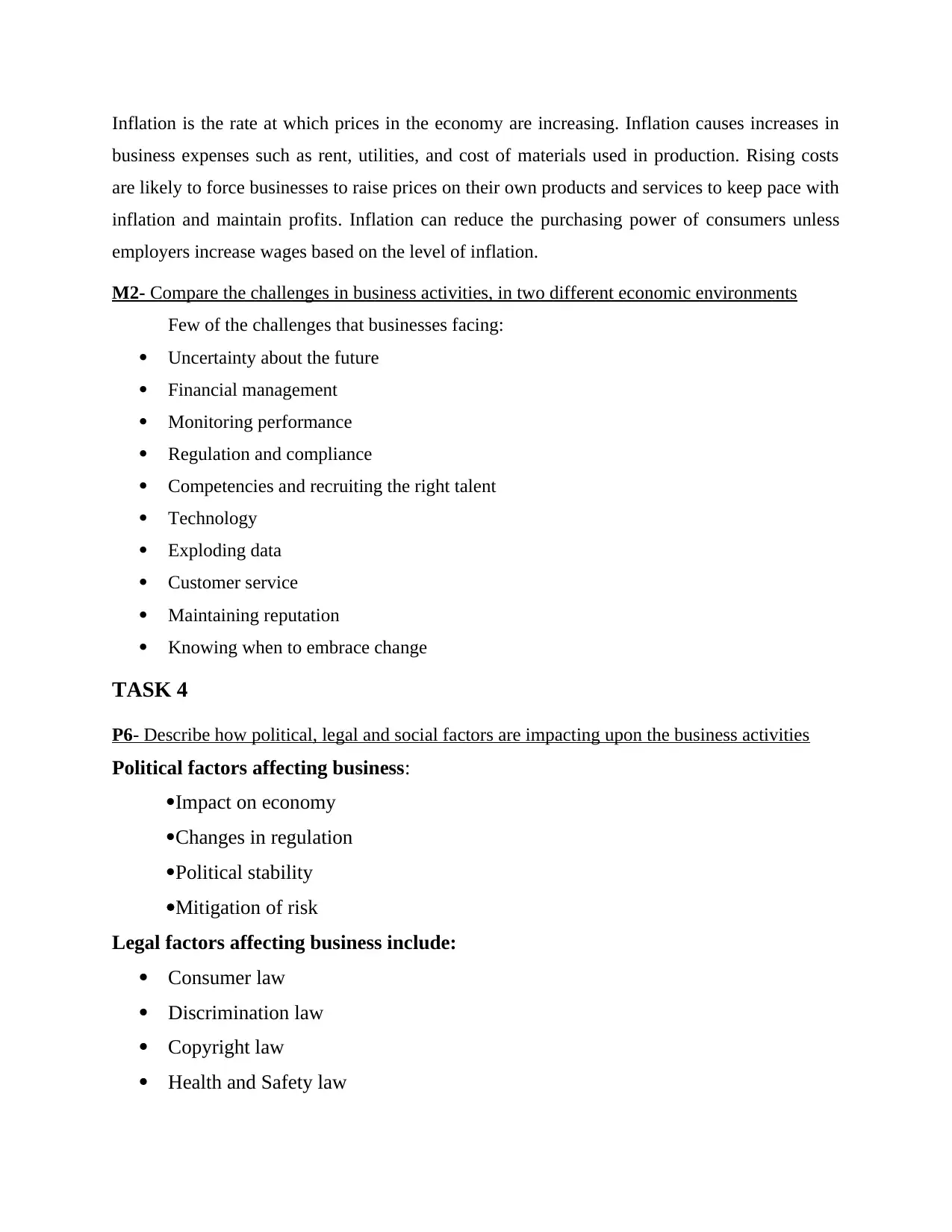
Inflation is the rate at which prices in the economy are increasing. Inflation causes increases in
business expenses such as rent, utilities, and cost of materials used in production. Rising costs
are likely to force businesses to raise prices on their own products and services to keep pace with
inflation and maintain profits. Inflation can reduce the purchasing power of consumers unless
employers increase wages based on the level of inflation.
M2- Compare the challenges in business activities, in two different economic environments
Few of the challenges that businesses facing:
Uncertainty about the future
Financial management
Monitoring performance
Regulation and compliance
Competencies and recruiting the right talent
Technology
Exploding data
Customer service
Maintaining reputation
Knowing when to embrace change
TASK 4
P6- Describe how political, legal and social factors are impacting upon the business activities
Political factors affecting business:
Impact on economy
Changes in regulation
Political stability
Mitigation of risk
Legal factors affecting business include:
Consumer law
Discrimination law
Copyright law
Health and Safety law
business expenses such as rent, utilities, and cost of materials used in production. Rising costs
are likely to force businesses to raise prices on their own products and services to keep pace with
inflation and maintain profits. Inflation can reduce the purchasing power of consumers unless
employers increase wages based on the level of inflation.
M2- Compare the challenges in business activities, in two different economic environments
Few of the challenges that businesses facing:
Uncertainty about the future
Financial management
Monitoring performance
Regulation and compliance
Competencies and recruiting the right talent
Technology
Exploding data
Customer service
Maintaining reputation
Knowing when to embrace change
TASK 4
P6- Describe how political, legal and social factors are impacting upon the business activities
Political factors affecting business:
Impact on economy
Changes in regulation
Political stability
Mitigation of risk
Legal factors affecting business include:
Consumer law
Discrimination law
Copyright law
Health and Safety law
⊘ This is a preview!⊘
Do you want full access?
Subscribe today to unlock all pages.

Trusted by 1+ million students worldwide
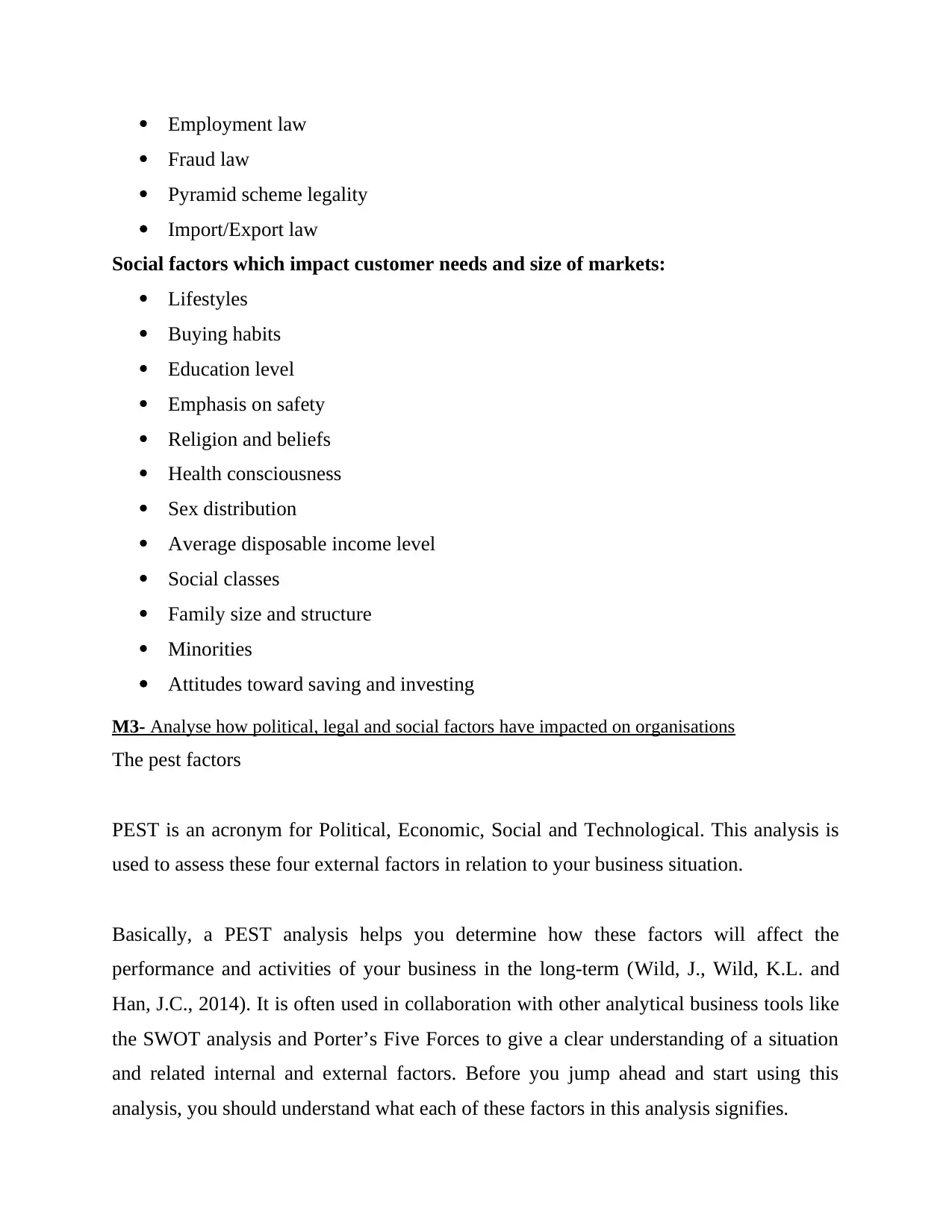
Employment law
Fraud law
Pyramid scheme legality
Import/Export law
Social factors which impact customer needs and size of markets:
Lifestyles
Buying habits
Education level
Emphasis on safety
Religion and beliefs
Health consciousness
Sex distribution
Average disposable income level
Social classes
Family size and structure
Minorities
Attitudes toward saving and investing
M3- Analyse how political, legal and social factors have impacted on organisations
The pest factors
PEST is an acronym for Political, Economic, Social and Technological. This analysis is
used to assess these four external factors in relation to your business situation.
Basically, a PEST analysis helps you determine how these factors will affect the
performance and activities of your business in the long-term (Wild, J., Wild, K.L. and
Han, J.C., 2014). It is often used in collaboration with other analytical business tools like
the SWOT analysis and Porter’s Five Forces to give a clear understanding of a situation
and related internal and external factors. Before you jump ahead and start using this
analysis, you should understand what each of these factors in this analysis signifies.
Fraud law
Pyramid scheme legality
Import/Export law
Social factors which impact customer needs and size of markets:
Lifestyles
Buying habits
Education level
Emphasis on safety
Religion and beliefs
Health consciousness
Sex distribution
Average disposable income level
Social classes
Family size and structure
Minorities
Attitudes toward saving and investing
M3- Analyse how political, legal and social factors have impacted on organisations
The pest factors
PEST is an acronym for Political, Economic, Social and Technological. This analysis is
used to assess these four external factors in relation to your business situation.
Basically, a PEST analysis helps you determine how these factors will affect the
performance and activities of your business in the long-term (Wild, J., Wild, K.L. and
Han, J.C., 2014). It is often used in collaboration with other analytical business tools like
the SWOT analysis and Porter’s Five Forces to give a clear understanding of a situation
and related internal and external factors. Before you jump ahead and start using this
analysis, you should understand what each of these factors in this analysis signifies.
Paraphrase This Document
Need a fresh take? Get an instant paraphrase of this document with our AI Paraphraser
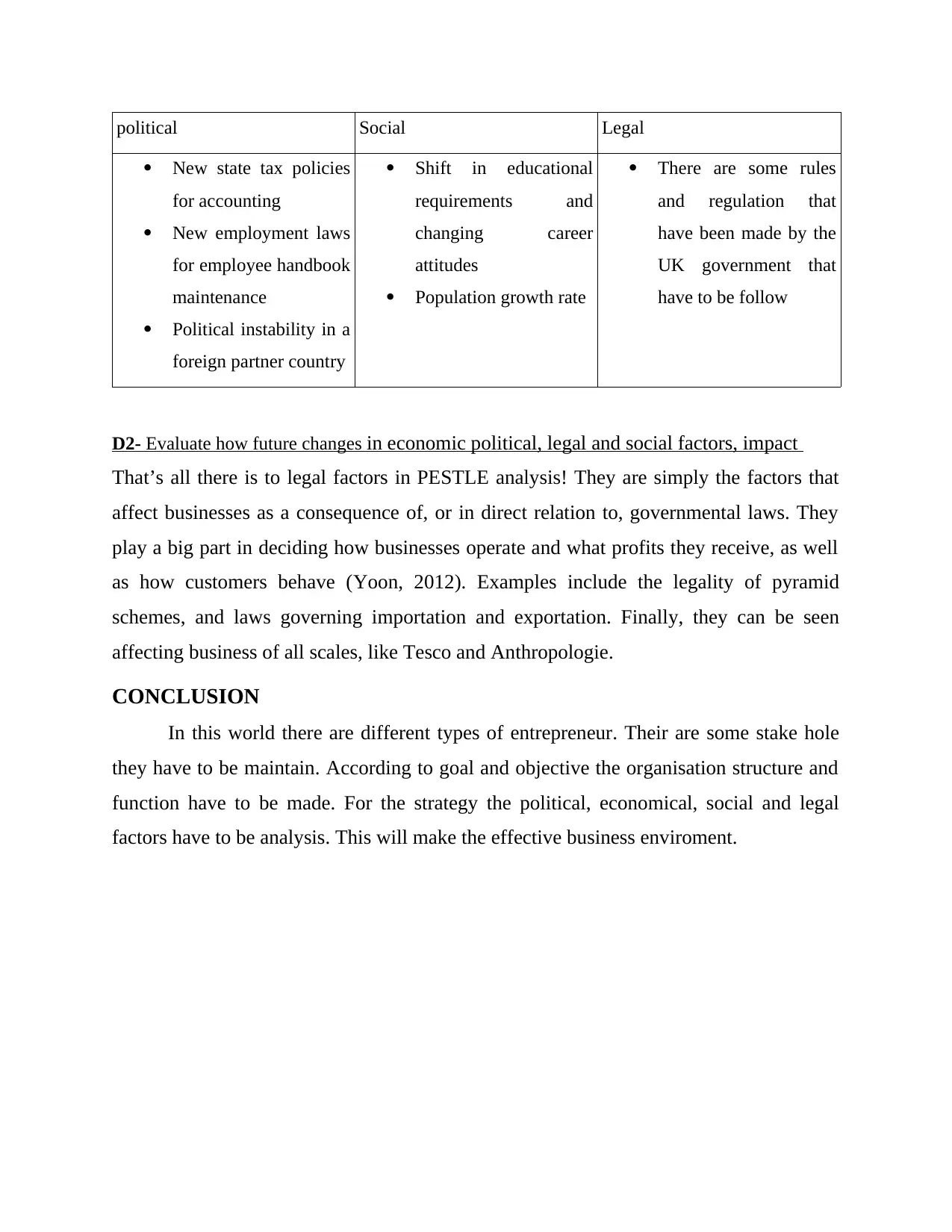
political Social Legal
New state tax policies
for accounting
New employment laws
for employee handbook
maintenance
Political instability in a
foreign partner country
Shift in educational
requirements and
changing career
attitudes
Population growth rate
There are some rules
and regulation that
have been made by the
UK government that
have to be follow
D2- Evaluate how future changes in economic political, legal and social factors, impact
That’s all there is to legal factors in PESTLE analysis! They are simply the factors that
affect businesses as a consequence of, or in direct relation to, governmental laws. They
play a big part in deciding how businesses operate and what profits they receive, as well
as how customers behave (Yoon, 2012). Examples include the legality of pyramid
schemes, and laws governing importation and exportation. Finally, they can be seen
affecting business of all scales, like Tesco and Anthropologie.
CONCLUSION
In this world there are different types of entrepreneur. Their are some stake hole
they have to be maintain. According to goal and objective the organisation structure and
function have to be made. For the strategy the political, economical, social and legal
factors have to be analysis. This will make the effective business enviroment.
New state tax policies
for accounting
New employment laws
for employee handbook
maintenance
Political instability in a
foreign partner country
Shift in educational
requirements and
changing career
attitudes
Population growth rate
There are some rules
and regulation that
have been made by the
UK government that
have to be follow
D2- Evaluate how future changes in economic political, legal and social factors, impact
That’s all there is to legal factors in PESTLE analysis! They are simply the factors that
affect businesses as a consequence of, or in direct relation to, governmental laws. They
play a big part in deciding how businesses operate and what profits they receive, as well
as how customers behave (Yoon, 2012). Examples include the legality of pyramid
schemes, and laws governing importation and exportation. Finally, they can be seen
affecting business of all scales, like Tesco and Anthropologie.
CONCLUSION
In this world there are different types of entrepreneur. Their are some stake hole
they have to be maintain. According to goal and objective the organisation structure and
function have to be made. For the strategy the political, economical, social and legal
factors have to be analysis. This will make the effective business enviroment.
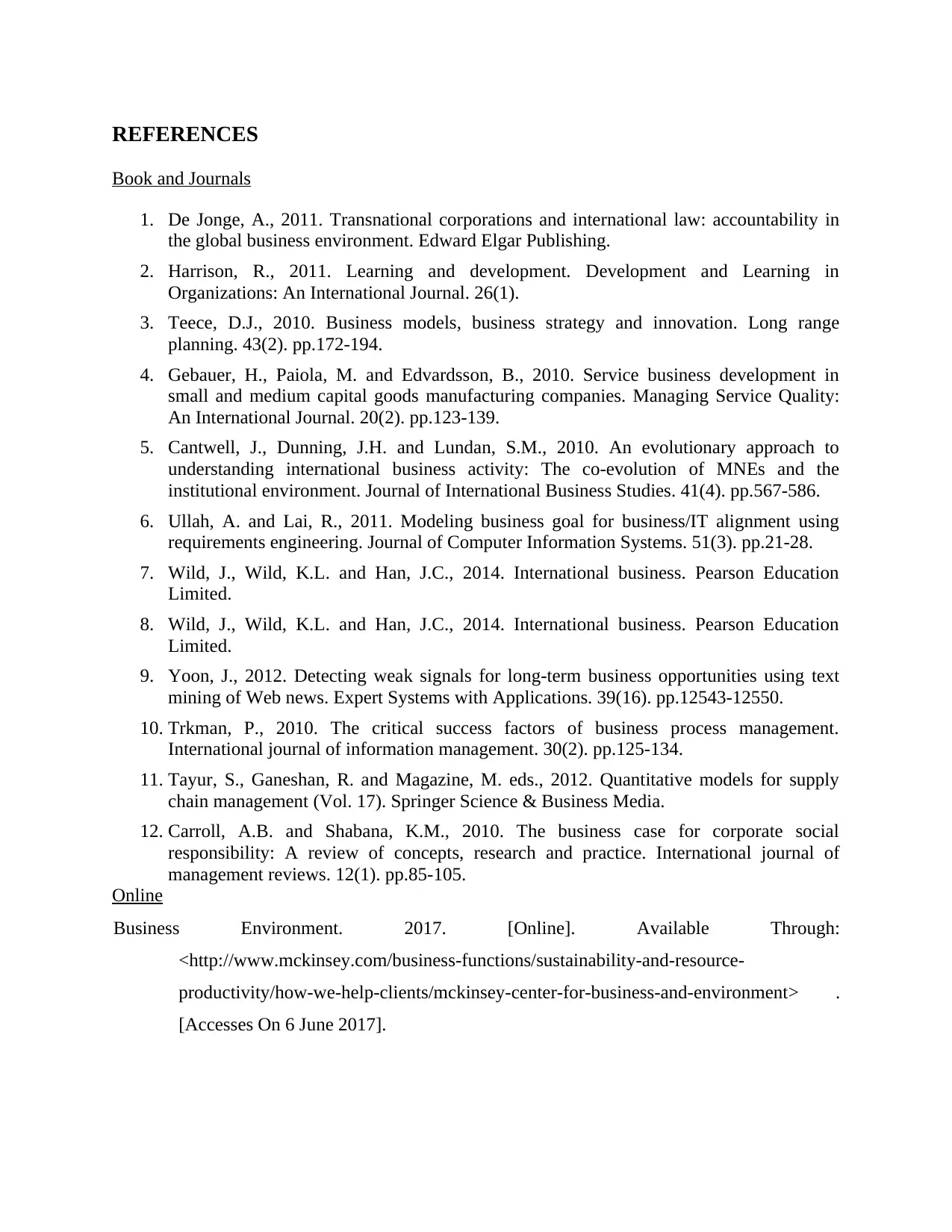
REFERENCES
Book and Journals
1. De Jonge, A., 2011. Transnational corporations and international law: accountability in
the global business environment. Edward Elgar Publishing.
2. Harrison, R., 2011. Learning and development. Development and Learning in
Organizations: An International Journal. 26(1).
3. Teece, D.J., 2010. Business models, business strategy and innovation. Long range
planning. 43(2). pp.172-194.
4. Gebauer, H., Paiola, M. and Edvardsson, B., 2010. Service business development in
small and medium capital goods manufacturing companies. Managing Service Quality:
An International Journal. 20(2). pp.123-139.
5. Cantwell, J., Dunning, J.H. and Lundan, S.M., 2010. An evolutionary approach to
understanding international business activity: The co-evolution of MNEs and the
institutional environment. Journal of International Business Studies. 41(4). pp.567-586.
6. Ullah, A. and Lai, R., 2011. Modeling business goal for business/IT alignment using
requirements engineering. Journal of Computer Information Systems. 51(3). pp.21-28.
7. Wild, J., Wild, K.L. and Han, J.C., 2014. International business. Pearson Education
Limited.
8. Wild, J., Wild, K.L. and Han, J.C., 2014. International business. Pearson Education
Limited.
9. Yoon, J., 2012. Detecting weak signals for long-term business opportunities using text
mining of Web news. Expert Systems with Applications. 39(16). pp.12543-12550.
10. Trkman, P., 2010. The critical success factors of business process management.
International journal of information management. 30(2). pp.125-134.
11. Tayur, S., Ganeshan, R. and Magazine, M. eds., 2012. Quantitative models for supply
chain management (Vol. 17). Springer Science & Business Media.
12. Carroll, A.B. and Shabana, K.M., 2010. The business case for corporate social
responsibility: A review of concepts, research and practice. International journal of
management reviews. 12(1). pp.85-105.
Online
Business Environment. 2017. [Online]. Available Through:
<http://www.mckinsey.com/business-functions/sustainability-and-resource-
productivity/how-we-help-clients/mckinsey-center-for-business-and-environment> .
[Accesses On 6 June 2017].
Book and Journals
1. De Jonge, A., 2011. Transnational corporations and international law: accountability in
the global business environment. Edward Elgar Publishing.
2. Harrison, R., 2011. Learning and development. Development and Learning in
Organizations: An International Journal. 26(1).
3. Teece, D.J., 2010. Business models, business strategy and innovation. Long range
planning. 43(2). pp.172-194.
4. Gebauer, H., Paiola, M. and Edvardsson, B., 2010. Service business development in
small and medium capital goods manufacturing companies. Managing Service Quality:
An International Journal. 20(2). pp.123-139.
5. Cantwell, J., Dunning, J.H. and Lundan, S.M., 2010. An evolutionary approach to
understanding international business activity: The co-evolution of MNEs and the
institutional environment. Journal of International Business Studies. 41(4). pp.567-586.
6. Ullah, A. and Lai, R., 2011. Modeling business goal for business/IT alignment using
requirements engineering. Journal of Computer Information Systems. 51(3). pp.21-28.
7. Wild, J., Wild, K.L. and Han, J.C., 2014. International business. Pearson Education
Limited.
8. Wild, J., Wild, K.L. and Han, J.C., 2014. International business. Pearson Education
Limited.
9. Yoon, J., 2012. Detecting weak signals for long-term business opportunities using text
mining of Web news. Expert Systems with Applications. 39(16). pp.12543-12550.
10. Trkman, P., 2010. The critical success factors of business process management.
International journal of information management. 30(2). pp.125-134.
11. Tayur, S., Ganeshan, R. and Magazine, M. eds., 2012. Quantitative models for supply
chain management (Vol. 17). Springer Science & Business Media.
12. Carroll, A.B. and Shabana, K.M., 2010. The business case for corporate social
responsibility: A review of concepts, research and practice. International journal of
management reviews. 12(1). pp.85-105.
Online
Business Environment. 2017. [Online]. Available Through:
<http://www.mckinsey.com/business-functions/sustainability-and-resource-
productivity/how-we-help-clients/mckinsey-center-for-business-and-environment> .
[Accesses On 6 June 2017].
⊘ This is a preview!⊘
Do you want full access?
Subscribe today to unlock all pages.

Trusted by 1+ million students worldwide
1 out of 12
Related Documents
Your All-in-One AI-Powered Toolkit for Academic Success.
+13062052269
info@desklib.com
Available 24*7 on WhatsApp / Email
![[object Object]](/_next/static/media/star-bottom.7253800d.svg)
Unlock your academic potential
Copyright © 2020–2025 A2Z Services. All Rights Reserved. Developed and managed by ZUCOL.





